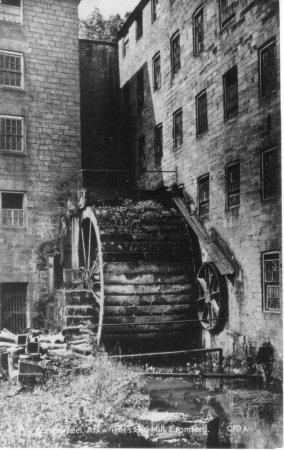One of the waterwheels which provided power for the First Mill

Waterwheel, Arkwright's First Mill, Cromford
Sir Richard Arkwright built his
First Mill on the Cromford site in 1771.
Early pictures of it show that it had five floors, well lit by windows
along its length. In the mid 1780's the building was extended to its
present length (the vertical joint towards the right of the mill is
clearly visible). Two new waterwheels were added, one facing the cliff,
and the other under the aquaduct. These wheels were destroyed long ago
and between the Wars the upper two storeys of the building were removed
after a serious fire.
To make the most economical use of the water the machinery was driven night and day. There was insufficient water to drive all the machinery at the same time, so the spinning went on at night and the preparation such as carding, combing, roving etc. was done in the day. William Bray visited Cromford around 1776 and said that the mill employed about 200 persons, chiefly children, who worked "by turns night and day", each shift worked for 12 hours.
The waterwheel shown was an overshot wheel. Water was supplied at the top, and fell down, turning the wheel. Water was taken from the Cromford Sough, where it was collected by a Dam. From the Dam, an iron aquaduct ran to the top of this wheel. Used water was then led to a basin, and then to the River Derwent, Cromford Meadows or to Cromford Canal.
In August 1771 Richard Arkwright and his partners signed a lease to the land and waterrights they needed to establish mills at Cromford. The partners must have worked quickly for the shell of the First Mill was practically complete by December 1771
Besides providing a building, Arkwright had to find a labour force to operate his machines. Part of his labour force was supplied locally - from the lead mining and farming families. In December 1771 an advert appeared in the Derby Mercury asking for skilled workmen from further afield.
Derby Mercury 1771 |
Dates:
Photo taken:
Size:
Source:
Click on photo for enlargement (on CD only)
Have any more information about this photo?
Please e-mail the author on:

